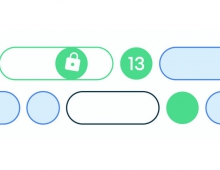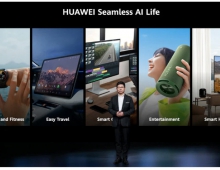
Huawei Unveils New "Harmony OS" for Use in Smartphones, Laptops and Other Devices
Richard Yu, head of Huawei's consumer business group, speaks at the Huawei Developer Conference in Dongguan, Guangdong province, China August 9, 2019. Huanqiu.com via REUTERS
Huawei Technologies unveiled on Friday its proprietary operating system for use in smartphones and other devices, as U.S. trade curbs imposed in May threaten to cut the Chinese firm’s access to U.S. technologies such as Android.
“Harmony OS is completely different from Android and iOS,” said Richard Yu, head of Huawei’s consumer business group, referring to operating systems developed by Google and Apple.
“You can develop your apps once, then flexibly deploy them across a range of different devices,” he told a developers’ conference held in Dongguan in southern China, where Huawei has built a lavish new campus modeled after European towns.
Harmony, called Hongmeng in Chinese, is ready for use in smartphones but Huawei prefers to stick to Android for now to support its app developers, Yu said, adding the Honor smart screen product it plans to unveil on Saturday will be the first product using the Harmony OS.
“Our HarmonyOS is more powerful and secure than Android, and it has greater distributed capability and is future-facing,” Yu said . “Can HarmonyOS be installed on smartphones? Of course.”
Yu went into back-end technical details but refrained from describing consumer-facing features, suggesting it may not yet be ready for prime-time.
For HarmonyOS to work, Huawei will need developers to build apps for its ecosystem. To help with app migration, HarmonyOS will be built on the Linux and Huawei’s own LiteOS kernels for now, Yu said, which will change in future generations of the OS.
However, the open-source software will initially find its way into everything from cars and watches to personal computers by 2020, said Yu. Earbuds and virtual reality goggles will follow.
He also said it would be difficult for Huawei to meet its previous goal of becoming the world’s biggest smartphone maker by shipments this year due to the U.S. curbs.
The company would have been able to ship 300 million smartphones this year without such restrictions, Yu said.
Competition with Apple
With “HarmonyOS,” Huawei actually mirrors Apple in developing a vertically-integrated supply and production lines that help reduce exposure to inclement market forces, unreliable suppliers and international trade disputes.
Apple’s strength has been the integration of software with hardware, and it has absolute control over iOS. Huawei is trying to do the same with HarmonyOS, but it has everything left to prove, starting today.
iTunes, the App Store and a dedicated following of enthusiastic app developers is a huge and profitable edge for Apple’s mobile business. In order to eventually bring HarmonyOS to smartphones, Huawei will need developers to build valuable apps for its ecosystem, which is another major question mark.
Both Apple and Huawei design their own processors but neither controls their actual production. Instead, they rely on Taiwan Semiconductor Manufacturing Co. to put them together and on SoftBank Group Corp.’s Arm for the licenses they need to design semiconductors.
SK Hynix, Samsung Electronics and Micron Technology produce storage parts for both the smartphone makers. The Koreans have a significant lead on RAM modules. Neither Apple nor Huawei has the capability to produce their own storage chips, though Huawei recently launched the Nano Memory Card.
As far as display tech is concerned, Samsung is the biggest supplier of the organic light-emitting diode displays that Apple uses for its iPhone X and XS top-tier devices. Others such as Japan Display and LG Display provide liquid-crystal display panels for the likes of the iPhone XR and earlier models. While Huawei is in much the same boat, it’s increasingly relying on home-team vendor BOE Technology Group Co. for its OLED panels, which are starting to win customers beyond China.
Modems are becoming more important with the transition to next-generation 5G technology. Apple recently agreed to buy Intel’s modem division, a step toward designing its own 5G chips. But Huawei is already among the leaders on this front, having announced the Balong 5G01 modem in February. As with processors, neither has its own silicon facilities so they’ll again be reliant on third party foundries.
Apple and Huawei are reliant on assemblers such as Hon Hai Precision Industry Co., also known as Foxconn. Both also tap other Taiwanese contract manufacturers, such as Pegatron Corp., Compal Electronics Inc. and Quanta Computer Inc., while Huawei also relies on Flex Ltd. But unlike Apple, which decided years to outsource much of its global production in China, Huawei operates a few highly automated lines to make top-tier P series phones.
Both Apple and Huawei rely on many other companies elsewhere in their smartphone production. U.S. companies Skyworks and Qorvo provide radio-frequency modules to facilitate 3G and LTE communications. NXP is the go-to supplier of NFC parts required for contactless payments. Sony is the leader in camera sensors and modules. And Apple-funded Corning Inc. supplies toughened glass.





















